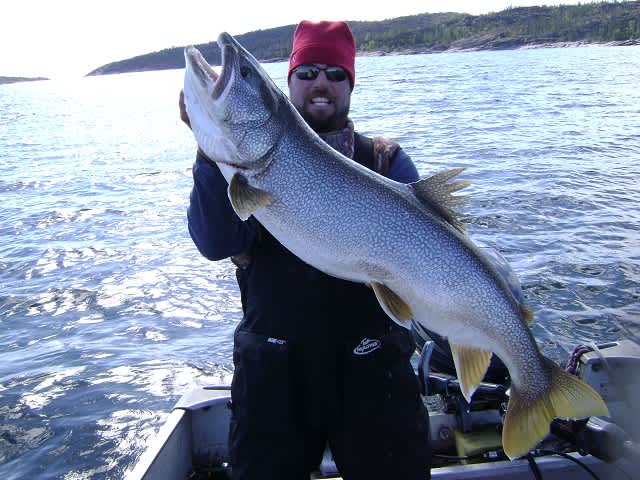Big Trout Eat Big Bait: Fishing for Trout on Lake Athabasca
Wild Fish Wild Places 02.21.12

When you’re looking to catch the biggest lake trout of your life, you need to think big water. What better place to chase a giant laker than the 7th largest lake in North America, Lake Athabasca?
Lake Athabasca is a remote body of water nestled in the Northern most part of Saskatchewan that is approximately 270 miles long and due to the abundant inflow of water and forage the predatory fish grow big. I have fished this lake a fair amount, spending hours looking for un-fished offshore reefs and big lake trout. It was during one such journey toward the end of June when we put together a pattern unlike anything I have ever witnessed. We were 20 miles from camp and the only boat that traveled east that day had one mission: big lakers!

There was no shortage of lake trout but we were not catching the giants we knew this lake is famous for. We noticed a couple of bigger fish chasing a small school of whitefish in and out of the rocky main lake reefs. As we watched them work the baitfish, we assumed they were trout and concluded the bigger lake trout were keyed in on 12 to 16 inch baitfish, much bigger than our medium-size spoons we were using, now we just had to imitate it. I started digging through my tackle and the only thing I had close to that size was a Luhr-Jensen size O dodger. I had heard the boys at Lakers Unlimited talking about the dodger fishing but had yet to put this technique to use, now was the time. In every situation I have fished dodgers in the past it was employed as an attractor with a leader and the bait/lure following, so this was going to be a test.
We connected a large single hook dressed with a plastic squid directly to the dodger, ran a 30” fluorocarbon leader to a 2 ounce weight connected to the main line and what used to be a big metal attractor had just become our lure. The fish were staging between 15 and 20 feet deep, ambushing prey in the boulders. As I released the large white and chartreuse dodger behind the boat I remember my buddy giggling and making some remark about how awful it looked and he was just going to stick with the small spoon he was using. The next few hours turned out to be one of the most memorable fishing experiences of my life, as not ten minutes after dropping in I had the most aggressive strike I had ever felt on the end of my line, boasting a beautiful 20 pound lake trout. The next hour was exactly the same with savage attacks followed by two more fish around 20 pounds, but I still did not rub it in and my buddy wasn’t willing to switch lures.
I dropped this beautiful piece of new hardware back into the crystal clear water and as I watched the lowrance call out a perfect 15 foot drop-off I estimated the time my lure would be flashing its way over the drop, it happened. The same savage attack and line stripping but this time it was much heavier and stronger. After doing battle with this beast it finally came into sight and as the two of us looked at each other we panicked, “don’t lose him, it’s a monster!” As we eased him into the cradle and attached the scale, he weighed in at a massive 38 pounds!
What a way to end the day and it was time to start rubbing it in. Since then I have used this technique on a few Canadian lakes with great results, as well as some local trout waters with smaller dodgers. Don’t be afraid to think outside the box or rub it in with your fishing buddies.

